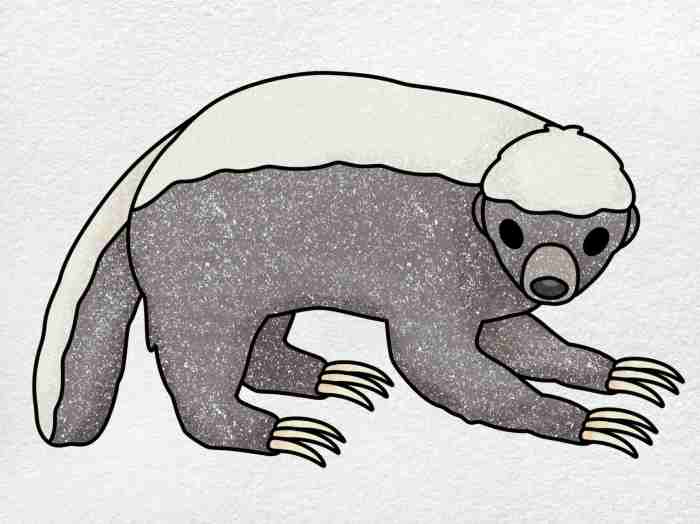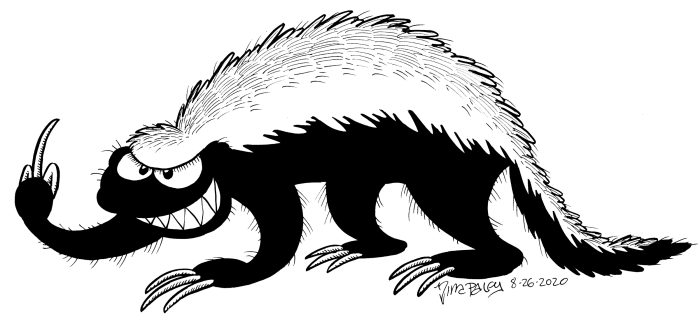Understanding the Search Term

Honey nadger drawing easy for kids – The search term “honey badger drawing easy for kids” reveals a multifaceted intent. It indicates a desire for simple, child-friendly instructions or visual guides on how to draw a honey badger. The simplicity requirement suggests a target audience with limited drawing skills, implying a focus on basic shapes and Artikels rather than intricate details.This search term likely targets a broad age range, predominantly children between the ages of 5 and 10.
Younger children might require more simplified instructions and assistance, while older children within this range may be able to follow slightly more complex steps. The ease of the drawing instructions is key to accommodating this varied skill level.
Age Range and Skill Level Considerations
The “easy” aspect of the search term is crucial. A drawing intended for a 5-year-old will differ significantly from one designed for a 10-year-old. A younger child might benefit from a step-by-step guide focusing on large, simple shapes, such as a circle for the body and smaller circles for the head and ears. An older child could handle more detailed features, including the characteristic markings on the honey badger’s face and body.
Consideration must be given to the child’s fine motor skills and ability to follow multi-step instructions. For example, a younger child might struggle with drawing small details like claws, while an older child would likely manage this with ease.
Safety Concerns Related to Depiction
While honey badgers are fascinating creatures, their depiction for children requires careful consideration. It’s essential to avoid portraying them in a way that glorifies their aggressive behavior or misrepresents their nature. The focus should be on presenting them accurately, highlighting their unique physical characteristics without emphasizing their ferocity. Avoid depictions showing the honey badger engaging in violent or aggressive acts towards other animals or humans.
The goal is to educate children about the animal’s appearance and habitat, not to encourage fear or aggression.
Appropriate and Inappropriate Depictions
An appropriate depiction of a honey badger for children might feature a friendly-looking honey badger with bright, expressive eyes, engaged in a non-threatening activity, such as foraging for food or playing. The drawing should accurately represent its physical features, such as its stout body, short legs, and distinctive black and white markings. The overall tone should be positive and informative.In contrast, an inappropriate depiction might show the honey badger in a violent or aggressive posture, attacking another animal or displaying exaggerated teeth or claws.
Images that anthropomorphize the honey badger to an excessive degree, giving it human-like emotions or behaviors that aren’t reflective of its actual nature, should also be avoided. For instance, a honey badger depicted as a snarling, villainous character would be inappropriate for a children’s drawing.
Illustrative Examples: Honey Nadger Drawing Easy For Kids

Creating honey badger drawings for children requires careful consideration of age appropriateness and artistic style. The level of detail, color palette, and technique should all be adjusted to match the target audience’s skill level and understanding. Below are examples demonstrating how to adapt a honey badger drawing for different age groups and purposes.
Honey Badger Drawing for Preschoolers
This drawing emphasizes simplicity and bold colors. The honey badger’s body is a simple, rounded shape, using thick, black lines for the Artikel. The legs are short and stubby, represented by simple shapes like rectangles and circles. The face is similarly simplified, with large, round eyes and a small, triangular nose. Colors are bright and primary—black for the Artikel, brown for the body, and white for the highlights in the eyes.
The overall effect is a playful and easily replicated image. The line weight is consistently thick throughout, making it easy for small hands to trace or copy.
Honey Badger Drawing for Older Children, Honey nadger drawing easy for kids
For older children, a more realistic approach can be taken. The body shape becomes more refined, incorporating subtle curves to suggest muscle and fur texture. The legs are longer and more detailed, with individual toes and claws indicated. Shading is introduced to create depth and dimension, using lighter browns and grays to show the honey badger’s fur.
So, you wanna draw a honey badger? Piece of cake, right? Seriously, it’s easier than assembling IKEA furniture. For even more simple drawing ideas, check out this list of baby easy drawing items – it’s got tons of inspiration for tiny tots (and surprisingly helpful for honing your honey badger skills). After all, mastering the basics is key before tackling those ferocious badger claws and grumpy expressions.
The face is more expressive, with more detailed features like whiskers and a more defined muzzle. Different line weights are used to create contrast and emphasis, with thicker lines outlining the main body shapes and thinner lines detailing smaller features. This allows for the exploration of shading techniques like cross-hatching or stippling, which would be too challenging for younger children.
Honey Badger Illustration for a Children’s Storybook
A honey badger illustration for a children’s storybook needs to be expressive and convey character. The honey badger’s pose and expression should match the scene in the story. For example, a honey badger looking mischievous might have a slightly tilted head and a playful glint in its eyes. A honey badger facing danger might have a more serious expression and a tense posture.
The line work can be more detailed, but still easily readable, and the color palette should complement the overall tone of the story. Think vibrant colors for a fun adventure or muted tones for a more serious narrative. The use of expressive eyes and body language is key to bringing the character to life.
Four Honey Badger Drawings in Different Poses and Expressions
| A honey badger digging in the ground, with its front paws extended and its head down, conveying determination. The color scheme is earthy browns and greens. | A honey badger lounging lazily in the sun, with its legs splayed out and its eyes half-closed, expressing relaxation. The colors are warm and sunny, with shades of yellow and orange. |
| A honey badger scampering playfully, its body slightly hunched and its legs moving quickly, showcasing energy and agility. The colors are bright and vibrant, with contrasting hues. | A honey badger standing tall and alert, its ears pricked and its gaze focused, showing vigilance. The color scheme is more subdued, emphasizing natural tones. |
Safety Considerations and Ethical Implications

Creating fun and engaging honey badger drawings for children requires careful consideration of potential pitfalls. While honey badgers are fascinating creatures, their portrayal in children’s art needs to be approached responsibly to avoid perpetuating harmful stereotypes and ensure a positive learning experience. This section will Artikel key safety and ethical considerations for parents, educators, and anyone creating or sharing honey badger-themed art with children.Potential Negative Stereotypes and Their AvoidanceHoney badgers are often depicted in popular culture as aggressive or even vicious creatures.
This can lead to negative stereotypes, particularly if the portrayal is simplistic or lacks nuance. To avoid this, children’s drawings should showcase a balanced representation of the honey badger’s personality. Instead of focusing solely on their fierce reputation, illustrate their intelligence, adaptability, and resourcefulness. Show them engaging in typical honey badger behaviors like digging, foraging, or interacting with their young in a playful way.
Remember, the goal is to create a well-rounded image that reflects the animal’s complexity without emphasizing only its aggressive traits. For instance, a drawing could depict a honey badger successfully finding food, showcasing its problem-solving skills rather than solely its ferocity.Accurate Representation of Animals to Avoid MisconceptionsAccurate representation is paramount. Children’s drawings should accurately reflect the honey badger’s physical characteristics, such as their distinctive markings and body shape.
Inaccurate depictions can lead to misconceptions about the animal’s appearance and even its biology. Avoid anthropomorphizing the honey badger excessively – giving it human-like characteristics or emotions – as this can distort children’s understanding of its natural behavior. For example, avoid depicting a honey badger wearing clothes or expressing emotions in a way that is incongruent with its natural behavior.
Instead, focus on realistic details like the honey badger’s claws, teeth, and distinctive facial features. Accurate representation fosters a more realistic understanding and appreciation for the animal.Potential Risks of Children Accessing Inappropriate ContentThe search term “honey badger” can unfortunately lead children to inappropriate content online. Some websites or images may contain graphic violence or sexually suggestive material, completely unsuitable for young audiences.
Parents and educators need to be vigilant in monitoring children’s online activity and ensuring they only access age-appropriate resources. Using child-safe search engines and actively supervising their online exploration is crucial. It is important to have open conversations with children about online safety and responsible internet usage. Teaching children to identify and report inappropriate content is an essential aspect of digital literacy.
Educating them about the difference between safe and unsafe websites, and encouraging them to seek help if they encounter something concerning, can mitigate potential risks.Guidelines for Selecting and Using Age-Appropriate ResourcesWhen selecting resources for children’s honey badger drawings, prioritize reputable sources like educational websites, children’s books, and nature documentaries. Ensure that the visual content is age-appropriate and avoids graphic or violent imagery.
The chosen resources should provide accurate information about honey badgers and promote a respectful understanding of wildlife. Before presenting any resource to a child, preview the content to assess its suitability. Consider the child’s age and maturity level when choosing drawings or activities. For younger children, simpler, more cartoonish depictions might be more suitable, while older children can handle more detailed and realistic representations.
Always emphasize the importance of responsible animal interaction and conservation efforts. Remember, the goal is to foster a love and respect for nature, not to instill fear or misinformation.
FAQ Resource
What materials do I need to draw a honey badger?
Paper, pencils, crayons, colored pencils, or markers will work perfectly. Feel free to get creative!
Are there any online resources for honey badger images?
Yes, but always supervise children’s online activity and stick to reputable websites. Search for “honey badger images for kids” to find age-appropriate options.
How can I make the drawing process less frustrating for my child?
Keep it light and fun! Focus on the process, not perfection. Start with simple shapes and let them add their own creative touches.
My child is scared of honey badgers. How can I approach this?
Focus on their positive attributes – their strength, cleverness, and unique features. Use age-appropriate books or videos to help them learn more and overcome their fear.
